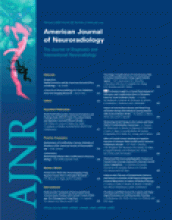Abstract
BACKGROUND AND PURPOSE: Embolization of arteriovenous malformations (AVMs) is commonly used to achieve nidal volume reduction before microsurgical resection or stereotactic radiosurgery. The purpose of this study was to examine the overall neurologic complication rate in patients undergoing AVM embolization and analyze the factors that may determine increased risk.
MATERIALS AND METHODS: We performed a retrospective review of all patients with brain AVMs embolized at 1 center from 1995 through 2005. Demographics, including age, sex, presenting symptoms, and clinical condition, were recorded. Angiographic factors including maximal nidal size, presence of deep venous drainage, and involvement of eloquent cortex were also recorded. For each embolization session, the agent used, number of pedicles embolized, the percentage of nidal obliteration, and any complications were recorded. Complications were classified as the following: none, non-neurologic (mild), transient neurologic deficit, and permanent nondisabling and permanent disabling deficits. The permanent complications were also classified as ischemic or hemorrhagic. Modified Rankin Scale (mRS) scores were collected pre- and postembolization on all patients. Univariate regression analysis of factors associated with the development of any neurologic complication was performed.
RESULTS: Four hundred eighty-nine embolization procedures were performed in 192 patients. There were 6 Spetzler-Martin grade I (3.1%), 26 grade II (13.5%), 71 grade III (37.0%), 57 grade IV (29.7%), and 32 grade V (16.7%) AVMs. Permanent nondisabling complications occurred in 5 patients (2.6%) and permanent disabling complications or deaths occurred in 3 (1.6%). In addition, there were non-neurologic complications in 4 patients (2.1%) and transient neurologic deficits in 22 (11.5%). Five of the 8 permanent complications (2.6% overall) were ischemic, and 3 of 8 (1.6% overall) were hemorrhagic. Of the 178 patients who were mRS 0–2 pre-embolization, 4 (2.3%) were dependent or dead (mRS >2) at follow-up. Univariate analysis of risk factors for permanent neurologic deficits following embolization showed that basal ganglia location was weakly associated with a new postembolization neurologic deficit.
CONCLUSION: Embolization of brain AVMs can be performed with a high degree of technical success and a low rate of permanent neurologic complications.
- Copyright © American Society of Neuroradiology












